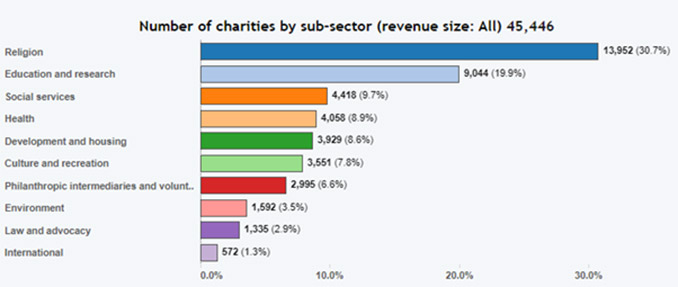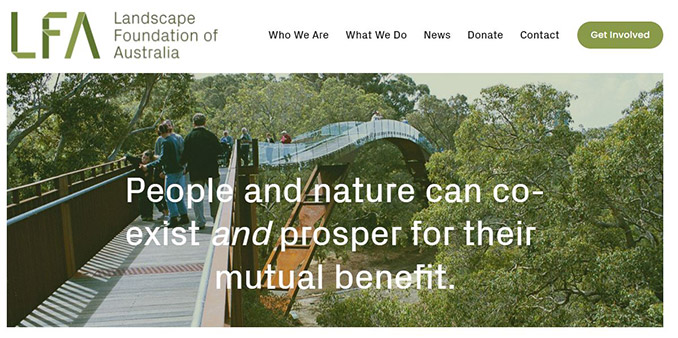Article written by Noel Corkery is a Fellow and Past National President of AILA and a Registered Landscape Architect. He is a Founding Director of the recently established Landscape Foundation of Australia.
In an interview with the US-based Landscape Architecture Foundation, Jeffrey Hou, professor of landscape architecture at the University of Washington, was asked, “Where do you think the profession needs to go from here?” His response was: “The profession needs to scale up, reach out and explore alternative models of practice. It needs to reach out, not only through marketing and publicity but also to engage more substantially at both the community level and in policy discussions.” Hou went on to say that to engage at these levels, the profession needs to explore new ways to organise itself and identify areas in which professional knowledge and skills can be applied to better serve society.[1]
On a similar note, a recent post on the American Society of Landscape Architects’ blog, ‘The Dirt’, featured an interview with Richard Weller, professor, and chair of landscape architecture at the University of Pennsylvania. Weller was asked, “How can landscape architecture academics and practitioners better partner to address the twin challenges of biodiversity loss and climate change?” He answered that there are two forms of design that need to be addressed to bring practitioners and academics together. The first, adopting a whole-of-city approach to considering how urban growth can occur with minimal impact on biodiversity. The second, addressing biodiversity holistically at the project scale and taking account of all living elements affected. Weller acknowledged that to successfully address both these forms of design is beyond the knowledge of landscape architects and they demand interdisciplinary teams of academics and practitioners. [2]
The commercially competitive and often adversarial environment in which most landscape architects in private practice work is generally not conducive to collaboration. Their clients are typically not the people who will use or directly benefit from the outcome of the landscape architects’ design work. Undertaking project work with not-for-profits is an “alternative mode of practice” that can provide landscape architects opportunities to work more directly in the service of communities and apply their design expertise in collaboration with experts in other disciplines.
In the case of research, academic and practice collaborations help to frame the relevant research questions and then disseminate the findings to the individuals and organisations who can effectively apply them.
While a number of landscape architecture practices in Australia undertake pro bono projects, the potential for engagement of landscape professionals with not-for-profits remains relatively unexplored. For many landscape architects, the not-for-profit sector is somewhat of a blind spot that needs to be addressed. The sector provides a wide range of opportunities for landscape architects to broaden and deepen the extent of their involvement at the community level, in research and in influencing policy decisions.
The not-for-profit sector in Australia is a significant contributor to the national economy. The Australian Productivity Commission’s 2010 Report noted that the sector comprised approximately 600,000 organisations that had been established for community purposes.[3] The Australian Charities and Not-for-Profit Commission (ACNC) 2018/19 Annual Report confirmed that not-for-profits in Australia had combined revenue of AUD155.4 billion, engaged 3.7 million volunteers, employed over 16% of Australia’s workforce (directly and indirectly), held assets worth $354 billion and contributed over 8% to Australia’s Gross Domestic Profit.[4] An indication of the relative scale of the major sub-sectors of registered charities in Australia is provided by Figure 1

Charities registered in the environment sub-sector are focused on the preservation of flora and fauna or environmental conservation. They may include land care groups, wildlife protection groups, trusts established to preserve or restore the natural environment and waste minimisation organisations.
The not-for-profit sector sits alongside the profit-focused commercial sector of the economy and is underpinned by an extensive network of support services and organisations. These include the Institute of Community Directors Australia, which provides professional development and a registration program for directors involved in the governance and administration of not-for-profit organisations, and Our Community which links to a diverse network of resources and support services.
The legal and medical professions have long been involved in offering pro bono services to local communities in need, both in their immediate locations and internationally. Working pro bono is when professional work is undertaken in a volunteer capacity, without payment (or for reduced fees), as a public service. It differs from traditional volunteering in that it is a service that applies specific professional skills to deliver services to people who are not able to afford them. A widely-known example is the independent, international organisation, Médecins sans Frontières (MSF)—Doctors without Borders—which provides medical services in disaster areas, war zones, and countries affected by the endemic disease.
MSF’s identity of being “without borders” has inspired the missions and names of not-for-profits focused on built environment outcomes such as Engineers Without Borders (EWB) and Architects without Frontiers (AWF). Both are Australian affiliates with links to international organisations. EWB Australia creates opportunities for engineering professionals and students to engage in community assistance projects primarily overseas but also in Australia. The projects benefit not only the recipients of aid and development projects but also the volunteers who obtain valuable personal and professional development experience. AWF partners with professional architects to provide pro bono services for the design and construction of health, education and community structures in Australia and the Asia Pacific region.
Australia has an impressive array of not-for-profit environmental organisations including Australian Conservation Foundation, Bush Heritage, Landcare, The Nature Conservancy and World Wildlife Foundation. These groups generally concentrate on the protection, restoration, conservation, and management of significant tracts of land and/or individual plant and animal species. However, there are few not-for-profit organisations, apart from professional membership societies or institutes, that have been formed by or mainly involve landscape architects.
In the USA, the Landscape Architecture Foundation, now 50 years in operation, is the leading not-for-profit that promotes research, student scholarships, and professional fellowships as well as advocating for the “influence and impact of landscape architects … to create a more sustainable, just and resilient future.” In the UK, the Landscape Research Group funds research by academics and practitioners involved in any aspect of the landscape, that emphasizes collaboration and exchange.
With these models in mind, the Landscape Foundation of Australia (LFA) was recently established as a not-for-profit organisation with charity status to support the protection, restoration and sustainable management of landscapes and natural environments in Australian cities and towns. The LFA supports and funds research, scholarships/fellowships and community-based projects that contribute to the achievement of sustainable and equitable urban landscapes.

The establishment of the LFA adds a new and valuable capability to the existing Australian environmental organisations mentioned above. With its emphasis on the human-nature interactions that occur in urban open spaces, at the peri-urban, and in areas rich with existing biodiversity, the LFA provides a platform for Australian landscape architects to broaden and deepen their effectiveness in addressing the complexities of urban ecologies.
The LFA engages a broad range of volunteers and supporters including landscape architects, ecologists, environmental engineers, social planners, and economists. It encourages and facilitates interdisciplinary collaboration to address the complex challenges presented by climate change, environmental degradation, biodiversity loss, environmental and community health that necessarily require a broader cross-section of the community and a combination of professionals to develop and implement effective and sustainable responses.
Local community groups will benefit from the LFA by pro bono landscape architectural expertise made available to help plan, design and implement their community-based projects. The result will be a heightened awareness of the landscape profession and its contribution to creating more equitable and sustainable urban environments that enhance community health and wellbeing.
The LFA is a separate organisation from the Australian Institute of Landscape Architects (AILA). However, the two organisations are complementary and collaborate where appropriate to further their common aims. The fundamental difference is that the AILA is a professional membership-based institute with a primary focus on supporting its members and promoting the landscape architecture profession in Australia, funded through membership fees and industry sponsorship. In contrast, the LFA is a not-for-profit organisation with a broad range of supporters and collaborators funded by donations, grants and philanthropic contributions.
Not-for-profit organisations such as the LFA rely heavily on volunteers to achieve their objectives, but they also provide substantial benefits to the volunteers who engage in positive action. The beneficial effects of volunteering on health outcomes have been well documented. Research has found that participation in voluntary services is significantly predictive of better mental and physical health, life satisfaction, self-esteem, and happiness as well as lowering depressive symptoms, psychological distress, and mortality.
Researchers at the University of Georgia found that people who perform volunteer work, far from being distracted by it, tend to perform better at their full-time jobs. The decisive factor behind the positive outcomes is that people have a strong desire for meaning; when they work at an organization or in a job that is meaningful to them, they want to engage more deeply with it. [5]
The United Nations “Human Development Report” and the OECD’s “How’s Life?” emphasize the benefits of being involved in voluntary activities. These include being connected with your community and building positive relationships through creating social capital, and building bonds of trust, cooperation, and respect for diversity. Both publications provide important recognition of the contribution that volunteering makes to well-being and human development.
Not-for-profits have the capacity to greatly broaden and deepen the role and effectiveness of the landscape profession in addressing the urgent challenges of climate change, biodiversity loss and community health through the application of design thinking across multiple scales, ranging from local community-based projects to city-wide, regional, national, and global initiatives. Involvement in not-for-profits should increasingly be seen as a key aspect of being a landscape architect.
References
[1] https://www.lafoundation.org/news/2018/11/perspectives-jeff-hou
[3] Australian Productivity Commission’s 2010 Report, https://www.pc.gov.au/inquiries/completed/not-for-profit/report
[4] Australian Charities and Not-for-Profit Commission, 2018/19 Annual Report, https://www.acnc.gov.au/tools/reports/acnc-annual-report-2018-19
Article written by Noel Corkery is a Fellow and Past National President of AILA and a Registered Landscape Architect. He is a Founding Director of the recently established Landscape Foundation of Australia.
Cover Image: Courtesy of Landscape Foundation of Australia
